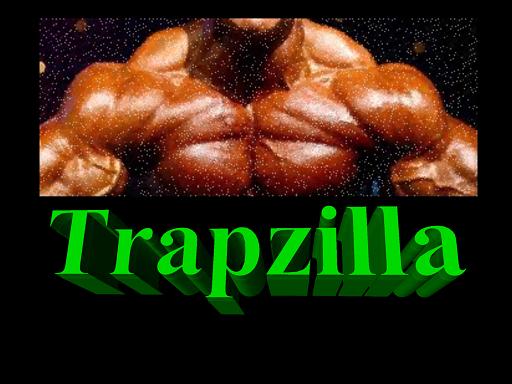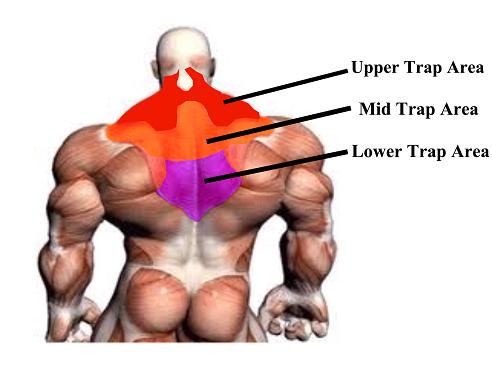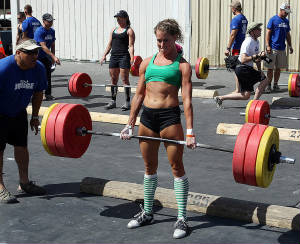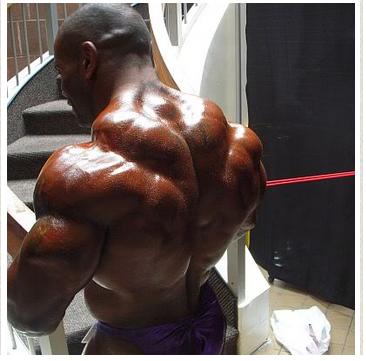|

You always hear about chest, leg, back, shoulder,
and arm training. Occasionally you will get some calve training articles and
summertime of course the six pack articles. What you don’t get though is a lot
of trap training articles. Building a big old yolk via trap training will make
anyone look like a beast. While a powerful set of traps will make a normal guy
look like a man’s man. A good set of
traps will also help a woman look more lady like in certain areas also. Besides
making you look big, powerful or sexy, big strong traps will help improve
overall functional.
Anatomy
of the Trapezius-
Trapezius gets its name from its trapezium-like
shape when looking at both muscles at once: the corners being the neck, the two
shoulders, and the thoracic vertebra.The muscles of the trapezius, starts at
the base of the skull and extends down to the middle of the back. From the
spine it also extends laterally to the scapula.
The trapezius has 3 functional regions: The superior
region (descending part) supports the weight of the upper limb. The
intermediate region (transverse part) retracts the scapulae. The inferior
region (ascending part) medially rotates and depresses the scapulae.
Because the fibers in the traps run in different
directions, it has a variety of actions.
The superior fibers or “upper traps” start at the
base of the skull and attach to the back third of the upper shoulder blades.
The main functions of the upper traps are to support to the arms. The upper
traps control scapular elevation. This includes shrugging up and lifting of the
shoulders. The upper traps are what gives a man that dominate appearance.
The middle fibers of the traps or “middle traps” are
just below the upper traps and run laterally across the rear shoulder blades
and vertebrae. This part helps with scapular retraction pull the shoulder
blades back (drawing the shoulder blades toward the midline). Because the
middle traps helps pull the shoulders back this area is important for women.
When the shoulders pull back the chest stands more upright helping a woman look
more “shapely” up top.
The inferior fibers or “lower traps” is the lowest
part of the traps. The lower traps help lower the scapula and helps with scapular
depression (pulling the shoulder blades down).

Keep
It Steady-
There is no doubt that a monstrous pair of traps can
make a person quite an impressive looking specimen. Traps however are much more
than an impressive show muscle. Well developed traps help greatly in improving
upper body strength and stability. Traps not only help with pulling and or
lifting but also help in opening up the upper chest for better breathing. When
moving the scapula the traps help provide stability to the spine. In contrast
when moving the spine the traps also help provide stability to the scapula.
With a lot of shoulder injuries, a lack of scapula mobility
and stability are the culprits. By developing a good set of traps scapula
mobility and stability can be aided. As a matter of fact some therapist will
provide shoulder rehab programs that include some shoulder shrugging motions. Shrugging motions directly target the
traps.

Beyond The
Basics-
When it comes
to targeting the traps most people don’t go beyond a couple basic shrugging movements. A few sets of barbell shrugs
and maybe a couple sets of dumbbell shrugs and that wraps it up for most people. Shrugs are probably the best known and most
direct way to hit the traps. Adding variation to the ways of hitting the traps however develops different parts of the traps.
To really work your traps though, you want to go beyond a few sets of barbell shrugs.
Variety Is The Spice-
As the saying goes “variety
is the spice of life!” Here are a few trap exercises that could really improve your trap development and add some
variety to those plain old shrugs.Here are a few choice exercises:
· Barbell Behind The
Back Shrugs

Deadlifts
Do you want to gain
some monster size on your traps? Look no further than the deadlift! Not only
will the deadlift put slabs of meat on your body but it will build some monster
traps fast. No exercise keeps constant tension on the traps longer than the deadlift...not even shrugs! While the deadlift
is not a trap exercise per say, the movement keeps
the traps under tension for a long time making it an excellent trap builder.
Wide Grip Shrugs
Wide grip shrugs put a totally different feel
to trap training. By taking a wider grip, it really hits the traps on the
outside and to a degree the rear delts. Wide grip shrugs also help improve
shoulder stability and back posture. To perform
the wide grip shrug, grip a barbell with your hands at
least 1 1/2 times the width of your shoulders. While keeping your body mostly
stationary, shrug your shoulders up, pause at the top for a count of one second,
and lower the bar. Be sure not to bend the arms and only lift the bar straight
up and down.

Barbell Shrug Behind The Back
While regular shrugs tend to focus more on the
upper traps, the behind the back version hits the upper and middle areas of the
traps. The behind the back shrug places your shoulders further behind you
allowing for more middle trap muscle recruitment. Hold a barbell behind your
back with your palms facing backwards. "Shrug" your shoulders upward
as high as you can and squeeze it for a second. Then lower the bar all the way
down as far as you can. To get the barbell into position, you can rest it on a
power rack or bench and then pick it up from there. You can also do these with
dumbbells, a cable apparatus, or the smith machine. The Smith machine or
cable apparatus can allow you to lean forward a little more for a longer
range of motion.
Bent Over Barbell Shrug (Gorilla Shrug)
The Bent Over Shrug or Gorilla Shrug as it is sometimes called does a great job
at hitting the mid to lower part of the traps. This movement gets it’s name
from the fact that you perform shrugs in a bent over position or the same
position as a gorilla when they are hunched over their knuckles. You start with
the barbell on the ground and you bend over it like you are getting into bent
over row position. Grab the bar with a shoulder width grip. Instead of rowing
the bar up keep your arms straight and pull up as high as you can. Hold at the
top for 1 second and return to the bottom.
Pullback Shrugs
Pullback Shrugs are
very similar to regular shrugs with just a slight variation in movement. They
focus more on the mid to lower trap while also hitting the top outside part of
the traps. To perform the pullback shrug set yourself up like you were to
perform a normal shrug. Instead of pulling straight up like a normal shrug, you
want to pull upwards and back. When you have the bar is upwards and back, you
want to try and squeeze the shoulder blades together as tight as possible. Hold
for 1 second and return to starting position.
Overhead Shrugs
This shrug variation
attacks the traps from an angle that is almost foreign to trap training. The
Overhead Shrug stimulates the traps from above.
Coming from the top really hits the upper traps. Another couple benefits
are this exercise does an incredible job of helping build shoulder stability
and aligning the sternum, two things crucial to upper body lifting.
The first thing you
are going to do for this exercise is greatly reduce the weight that you are
using. Pick up a barbell and press it overhead like a military press. Once you
have the bar in full lockout, keep your arms locked and shrug the barbell
upwards. You will only be able to move the bar a few inches but the key is
squeezing at the top. Not only will these cook your upper traps but your
shoulders will love them also.
Pulling
things together-
While a person can build a pretty good set of
traps from basic shrugs, they can build an even better set by learning to hit
their traps from different angles. By learning to use different angles you can
almost isolate the area of the traps you want to hit more for better overall
development.

|

